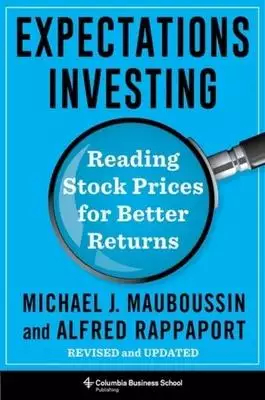New York Times stock的問題,透過圖書和論文來找解法和答案更準確安心。 我們找到下列股價、配息、目標價等股票新聞資訊
New York Times stock的問題,我們搜遍了碩博士論文和台灣出版的書籍,推薦Price, Margaret,Gianola, Jill寫的 Single Women and Money: How to Live Well on Your Income 和Mauboussin, Michael,Rappaport, Alfred的 Expectations Investing: Reading Stock Prices for Better Returns, Revised and Updated都 可以從中找到所需的評價。
這兩本書分別來自 和所出版 。
明志科技大學 視覺傳達設計系碩士班 劉瑞芬所指導 林貞瑜的 設計趨勢預測應用於設計思考流程之研究 (2021),提出New York Times stock關鍵因素是什麼,來自於設計趨勢、預測方法、設計思考、設計流程。
而第二篇論文逢甲大學 商學博士學位學程 賴文祥所指導 范志旻的 利用模糊層級分析法 探討半導體產業品牌影響因素之分析 (2021),提出因為有 模糊層次分析法、半導體產業品牌、關鍵影響因素的重點而找出了 New York Times stock的解答。
Single Women and Money: How to Live Well on Your Income

為了解決New York Times stock 的問題,作者Price, Margaret,Gianola, Jill 這樣論述:
Jill Gianola, a published author, teacher, speaker, and nationally known financial planner, has seen first-hand how women who are equipped with the know-how to make smart financial choices have changed their lives. Founder of Gianola Financial Planning, Gianola’s work has been recognized by such pub
lications as Mutual Funds magazine, which named her one of the top 100 planners in the US, and Money magazine, which featured her advice in "Secrets of America’s Top Advisors." Gianola is the author of The Young Couple’s Guide to Growing Rich Together. Gianola also wrote a regular column as the fami
ly finances expert for iVillage, a woman-focused website, and was the author of the "Your Money Questions Answered" column for AllYou. In addition to her work with her own clients, Gianola reaches a broader audience through the national financial press. She has been quoted regularly, including in th
e New York Times, Wall Street Journal, Kiplinger’s, and Barron’s, and she has appeared on personal finance segments on CNBC and CNN-fn. Gianola has taught personal finance courses at Ohio State University, Franklin University, and Columbus State Community College, and economics at Wittenberg Univers
ity. Margaret Price is an editor, author, and award-winning journalist. She has been an editor at Bloomberg Wealth Manager magazine, international editor at Crain Communications’ Pensions & Investments magazine and senior editor at Treasury & Risk Management magazine. She also has written for such p
rominent publications as Investor’[s Business Daily, New York Daily News, Newsday newspaper and the Christian Science Monitor. Price is a member and past president of the New York Financial Writers’ Association. She also is the author of the book, Emerging Stock Markets, A Complete Investment Guide
to New Markets Around the World. Active in her community, she is co-chair of the Women & Families Committee of Community Board 8-Manhattan. She also is a 2021 recipient of a New York State Woman of Distinction award, presented by State Assembly Member Rebecca Seawright.
New York Times stock進入發燒排行的影片
Taiwan already became a model for preventing the virus. But why does the WHO exclude Taiwan? In this episode, Ben Hedges explains why we need Taiwan to get through the coronavirus pandemic.
被全球公認是最佳防疫典範的台灣,為什麼還是被世界衛生組織WHO拒之門外?在本集的節目裡,英國主持人郝毅博將為大家介紹和分析這場全球大瘟疫中,為什麼我們不能少了被全球公認是最佳防疫典範的台灣。
#TaiwanCanHelp #WHO #COVID19
-
?訂閱老外節目請按小鈴鐺:http://bit.ly/2ZFnlue
?老外影片經常被黃標,請支持我們: http://bit.ly/ToLaoWai
-
?像你爸媽一樣追蹤老外臉書:
✅https://www.facebook.com/benhedgesntd
✅https://www.facebook.com/laowaintd
?我們也有沒什麼人看的推特,幫忙增加點人氣!
✅https://twitter.com/laowaintd
-
Our English Programs-
Crossroads with JOSHUA PHILIPP: https://bit.ly/2SxTIcY
China in Focus - NTD: http://bit.ly/2vzfm8x
China Uncensored: http://bit.ly/2O5UN72
American Thought Leaders: http://bit.ly/35rVxMR
Declassified With Gina Shakespeare: https://bit.ly/3fkAqlo
Larry Elder with Epoch Times: https://bit.ly/3b2aPdg
Zooming In with Simone Gao: https://bit.ly/3bZaOIs
-
Credits:
Shutterstock Images: https://shutr.bz/2u8Zdp8
Music: Audioblocks.com, epidemicsound.com
Stock Video: Videoblocks.com
©️ 版權所有
設計趨勢預測應用於設計思考流程之研究
為了解決New York Times stock 的問題,作者林貞瑜 這樣論述:
台灣近年愈來愈重視設計產業,政府提倡將設計作爲企業的目標策略與核心,不過目前許多政策仍在規劃階段,只有少數成功的大型企業,早已開始進行設計趨勢相關的研究工作,因此本研究動機為瞭解企業執行設計趨勢的目的與過程,以及對設計師的影響。本研究採用質性研究中的半結構式訪談,以台灣本土大型科技企業之設計中心作為本研究之個案,透過研究目的:一、瞭解企業內部如何進行設計趨勢預測與彙整。二、企業內之設計師如何應用設計趨勢進行設計思考與發想。三、設計趨勢對於企業內的設計師的影響為何。以及文獻探討的歸納,聚焦於企業中執行設計趨勢預測與設計思考之流程及應用,以及企業內之設計師認為趨勢預測之於個人或公司之影響,訪綱分
為四大類,共26道題目,分別訪談八位參與過設計趨勢研究之設計師,從中瞭解設計趨勢的重要性。本研究依照企業內部設計師們所提供的經驗與建議,研究者根據訪談結果提出下列點結論:1、企業內之設計中心執行趨勢,會綜合多種不同形式的團體預測方法使用,每年無固定使用之方法,會依據人員、目標的不同去做調整,訂定趨勢結論。;2、企業全體人員可從宏觀趨勢抓取機會點,在成立新專案時導入,而設計人員可從設計趨勢抓取應用面,在設計發想時導入使用,或是設計提案時導入設計理念中。;3、設計趨勢對於設計師而言,是一個與時俱進的工具書,使設計作品在產業界的壽命更加長遠。4.趨勢研究結果不需要強制在設計中心內部去做驗證,可以從市
場回饋中得到答案。
Expectations Investing: Reading Stock Prices for Better Returns, Revised and Updated

為了解決New York Times stock 的問題,作者Mauboussin, Michael,Rappaport, Alfred 這樣論述:
Michael J. Mauboussin is head of Consilient Research at Counterpoint Global, Morgan Stanley Investment Management. He is an adjunct professor of finance at Columbia Business School. His books include More Than You Know: Finding Financial Wisdom in Unconventional Places (Columbia, updated and expande
d edition, 2007); Think Twice: Harnessing the Power of Counterintuition (2009); and The Success Equation: Untangling Skill and Luck in Business, Sports, and Investing (2012). Alfred Rappaport is the Leonard Spacek Professor Emeritus at Northwestern University’s Kellogg School of Management. He is th
e author of Creating Shareholder Value (revised edition, 1997) and Saving Capitalism from Short-Termism: How to Build Long-Term Value and Take Back Our Financial Future (2011). Rappaport has been a guest columnist for the Wall Street Journal, the New York Times, the Financial Times, Fortune, and Bus
inessWeek.
利用模糊層級分析法 探討半導體產業品牌影響因素之分析
為了解決New York Times stock 的問題,作者范志旻 這樣論述:
隨著時間的流逝,半導體創新正在發生變化,可以適用於不同的創新業務,半導體業務的發展至關重要,因而開闢了許多新的職位。半導體業務是一個融合了不同創新能力並協調上游,中途和下游提供商的專業能力的行業,並且通常具有較高的進入壁壘 。廠家已投入花費很多精力與成本進入這個行業,期盼永續經營與回饋利害關係人。本研究第一步採用PEST, 五力 & SWOT分析,在美國,日本和臺灣,這些是國際半導體供應商鏈中的關鍵成員。經過最新半導體有關文獻的討論和分析,發現現有廠商已經建立了行業品牌,並獲得了用戶的信任。因此,品牌研究在這個行業是大家一直在探索的領域。考慮到寫作對話和大師談話,本研究使用分析層次結構(A
HP)研究技術對品牌的關鍵指針在半導體品牌的關鍵部件上進行重要性的排序,然後利用模糊層次分析法(FAHP)來分析這些標記之間的聯繫。經調查,有11項顯著結果可供參考,關鍵是要在半導體品牌建設上取得優異的成績,“客戶價值”和“品牌資產”都必須達到一定的水平。本研究發現,半導體品牌策略應以“客戶價值”為核心,解決客戶問題,創造卓越價值,並隨著技術的進步不斷投入新產品的研發,以奠定半導體品牌長期成功的基礎。